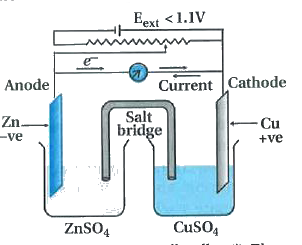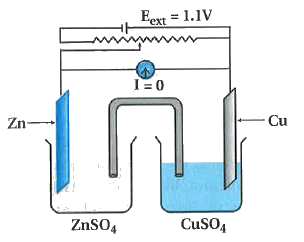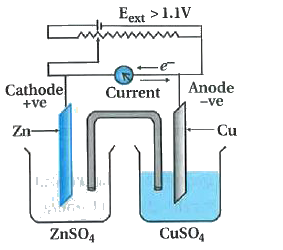Explain different condition when external potential is applied in opposite direction in galvanic cell (Voltaic cell) by taking suitable cell example.
Text Solution
(a) Condition-I: (Condition in which the flow of current continue through the galvanic cell or ): According to diagram-(a) if an external opposite potential is applied in the galvanic cell and increased slowly, we find that the reaction continues to take place till the opposing voltage reaches the value 1.1 V. Redox reaction continues in forward direction and reaction does not stops.
(a) 
In such condition in Daniel cell -(i) Electrode potential is between 0 to 1.1 V. (ii) Electrons flow from Zn rod to Cu rod hence current flows from Cu to Zn. (iii) dissolves at anode and hence its weight gets reduced. (iv) Cathode plate is of Cu and copper deposits at cathode.
(b) Condition-II: (Condition in which galvanic cell is stopped or ) : According to the diagram-(b), when the reaction stops altogether and no current flows through the cell. any further increase in the external potential again starts the reaction but in the opposite direction.
(b) 
In such condition in Daniell cell-(i) in Daniell cell when opposite external electrical potential and Daniell cell potential is 0.0V (ii) No flow of electrons or current. (iii) No chemical reaction. (iv) Daniell cell does not work.
(c) Condition-III: (condition in which electrochemical cell becomes electrolytic cell or : It now functions as an electrolytic cell, a device for using electrical energy to carry non-spontaneous chemical reactions.
(c) 
When , (i) Such cell become negative (ii) Daniell cell becomes electrolytic cell. (iii) Electrical energy gets converted into chemical energy and such electrical energy is utilized for non-spontaneous reaction. (iv) electrons flow from Cu to Zn and current flows from Zn to Cu.
(v) Zinc is deposited at the zinc electrode. (vi) Copper dissolves at copper electrode and it will present as ions.
|
Topper's Solved these Questions
- ELECTROCHEMISTRYBOOK - KUMAR PRAKASHANCHAPTER - ELECTROCHEMISTRYEXERCISE - SECTION-A (Try Yourself)
25 Videos
- ELECTROCHEMISTRYBOOK - KUMAR PRAKASHANCHAPTER - ELECTROCHEMISTRYEXERCISE - SECTION-A (Practice Questions)
3 Videos
- ELECTROCHEMISTRYBOOK - KUMAR PRAKASHANCHAPTER - ELECTROCHEMISTRYEXERCISE - SECTION-E MCQ.s Asked in GUJCET/Board Exam
55 Videos
- CHEMISTRY IN EVERYDAY LIFEBOOK - KUMAR PRAKASHANCHAPTER - CHEMISTRY IN EVERYDAY LIFEEXERCISE - SECTION - E (MCQs ASKED IN GUJCET/BOARD EXAM)
37 Videos
- GENERAL PRINCIPLES AND PROCESSES OF ISOLATION OF ELEMENTSBOOK - KUMAR PRAKASHANCHAPTER - GENERAL PRINCIPLES AND PROCESSES OF ISOLATION OF ELEMENTSEXERCISE - SECTION - E (MCQs ASKED IN GUJET/BOARD EXAMS)
46 Videos
Similar Questions
Knowledge Check
What is the difference between galvanic cell and electrolytic cell ?
AIn galvanic cell, electrical energy is profuced while in electrolytic cell electrical energy is consumedBIn galvanic cell, anode is (-) ve while in electrolytic cell anode is (+) veCIn galvanic cell, cathode is (+) ve while in electrolytic cell anode is (-) veDAll are correctThe most important condition for a galvanic cell is
AThe electrolysis should not have physical contactBThe electrolytes should be taken in a separate containeerCThe electrodes should be inertDThe two half cells should be connected internally by some devicesUnder what conditions is the Nernst equation used to calcualte cell potential voltages in a voltaic cell?
ANon standard concentration onlyBnon-spontaneous reactions onlyCReactions at equilibrium onlyDReactions of ions with the same charges only
What is galvanic cell ? Discuss briefly with one example.
View SolutionElectrolytic cell and Electrochemical cell or Galvanic cell or Voltaic cell.
View SolutionWhich of the following galvanic cells no liquid junction potential?
View SolutionIn voltaic cells potential difference is produced due to
View SolutionCell potential is the difference in ______ between the two electrodes of a galvanic cell that cause charge to flow.
View Solution
